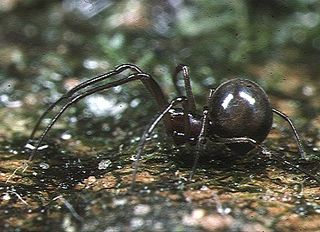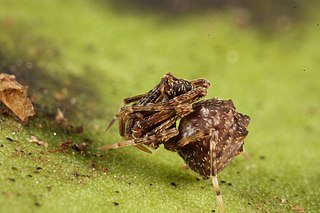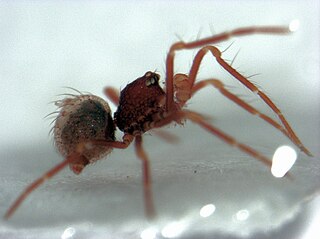
Desidae is a family of spiders, some of which are known as intertidal spiders. The family is named for the genus Desis, members of which inhabit the intertidal zone. The family has been reevaluated in recent years and now includes inland genera and species as well, such as Badumna and Phryganoporus. In 2017, the family Amphinectidae was merged into Desidae and the family Toxopidae was separated from it. Those intertidal spiders that are truly marine commonly live in barnacle shells, which they seal up with silk; this allows them to maintain an air bubble during high tide. They emerge at night to feed on various small arthropods that live in the intertidal zone.

Migidae, also known as tree trapdoor spiders, is a family of spiders with about 100 species in eleven genera. They are small to large spiders with little to no hair and build burrows with a trapdoor. Some species live in tree fern stems. They have a Gondwanan distribution, found almost exclusively on the Southern Hemisphere, occurring in South America, Africa, Madagascar, Australia, New Zealand and New Caledonia.

Orsolobidae is a six-eyed spider family with about 180 described species in thirty genera. It was first described by J. A. L. Cooke in 1965, and was raised to family status from "Dysderidae" in 1985.

Anapidae is a family of rather small spiders with 232 described extant species in 58 genera. It includes the former family Micropholcommatidae as the subfamily Micropholcommatinae, and the former family Holarchaeidae. Most species are less than 2 millimetres (0.079 in) long.

Archaeidae, also known as assassin spiders and pelican spiders, is a spider family with about ninety described species in five genera. It contains small spiders, ranging from 2 to 8 millimetres long, that prey exclusively on other spiders. They are unusual in that they have "necks", ranging from long and slender to short and thick. The name "pelican spider" refers to these elongated jaws and necks used to catch their prey. Living species of Archaeidae occur in South Africa, Madagascar and Australia, with the sister family Mecysmaucheniidae occurring in southern South America and New Zealand.

Holarchaea is a genus of South Pacific araneomorph spiders in the family Anapidae, and was first described by Raymond Robert Forster in 1955. As of May 2019 it contains only two species, H. globosa and H. novaeseelandiae, but there may still be undescribed species in New Zealand.

Mecysmaucheniidae is a family of araneomorph spiders first described by Eugène Simon in 1895. Most genera occur in South America, with two genera endemic to New Zealand.

The Micropholcommatinae are a subfamily of araneomorph spiders in the family Anapidae. They were previously treated as the family Micropholcommatidae. Micropholcommatins are extremely small, with body lengths typically between 0.5 and 2 mm. They are usually found among leaf litter or moss.
Wiltonia is a genus of Polynesian araneomorph spiders in the family Orsolobidae, and was first described by Raymond Robert Forster & Norman I. Platnick in 1985.

Austrarchaea is a genus of Australian assassin spiders first described by Raymond Robert Forster & Norman I. Platnick in 1984. 25 species were described by Michael Gordon Rix and Mark Stephen Harvey in 2011, 2012, and 2024.
Chilenodes is a monotypic genus of spiders in the family Malkaridae. It was first described by Platnick & Forster in 1987. As of 2023, it contains only one species, Chilenodes australis, found in Chile and Argentina.
Anarchaea is a genus of Australian shield spiders that was first described by Michael Gordon Rix in 2006.

Forstrarchaea is a monotypic genus of shield spiders from New Zealand containing the single species, Forstrarchaea rubra.
Ozarchaea is a genus of South Pacific shield spiders that was first described by Michael Gordon Rix in 2006.

Malkara loricata is a species of spiders in the family Malkaridae. It was first described in 1980 by Valerie Todd Davies. As of 2017, it is the sole species in the genus Malkara. It is found in Queensland.

Physoglenidae is a family of araneomorph spiders first described by Alexander Petrunkevitch in 1928 as a subfamily of Pholcidae. It was later moved to Synotaxidae until a study in 2016 showed that they formed a distinct clade.

Toxopidae is a small family of araneomorph spiders, first described in 1940. For many years it was sunk into Desidae as a subfamily, although doubts were expressed as to whether this was correct. A large-scale molecular phylogenetic study in 2016 led to the family being revived.













